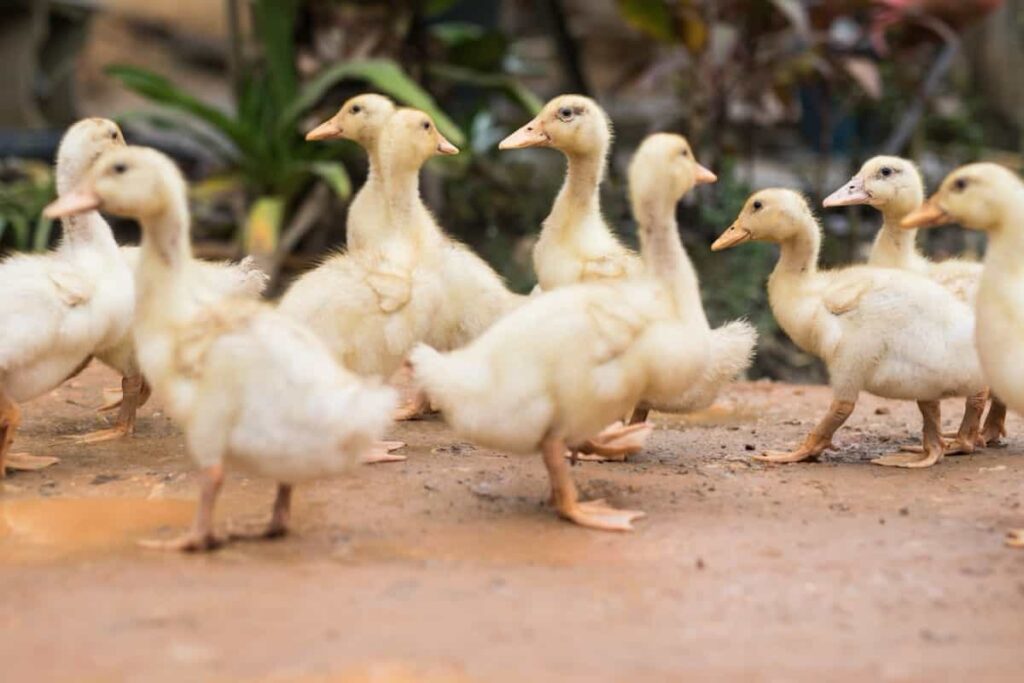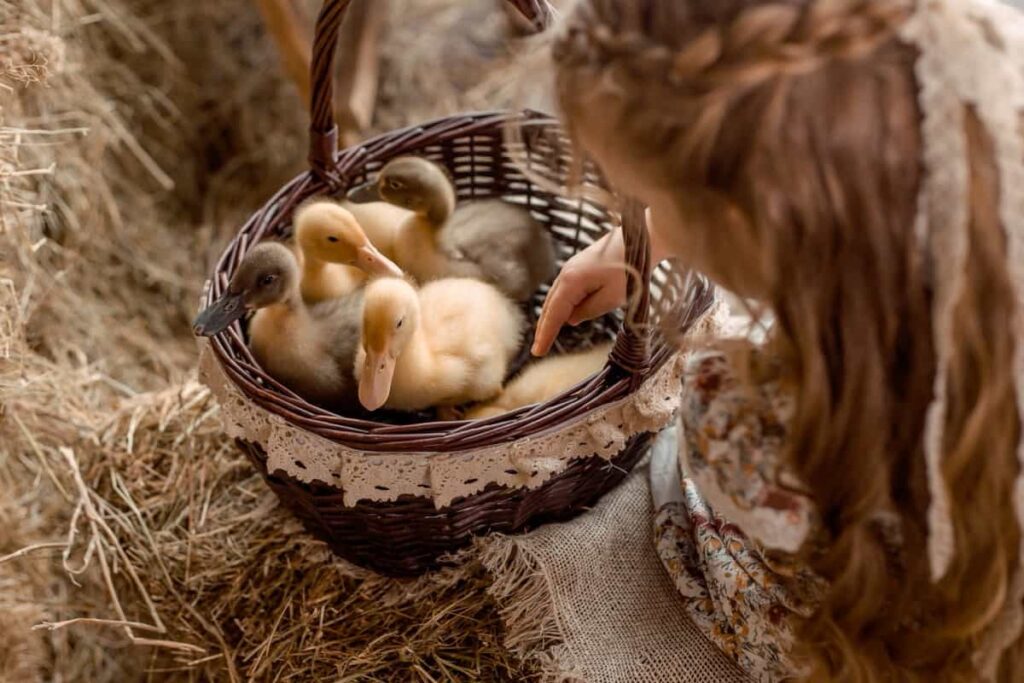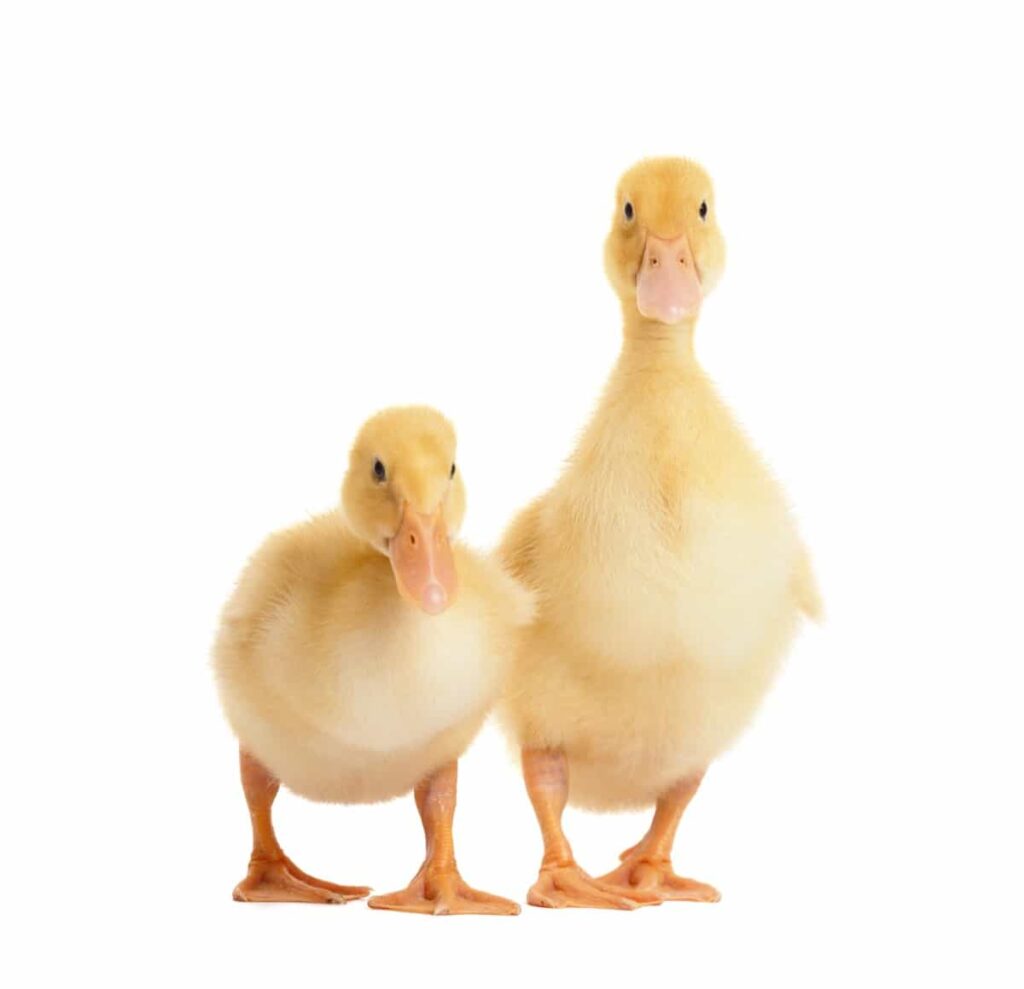Saxony Ducks originated in Germany in the 1930s through a crossbreeding program. Albert Franz developed them in Saxony-Anhalt, hence the name. Franz aimed to create a versatile breed with excellent egg-laying capabilities and good meat production. The Saxony Ducks gained recognition for their balanced attributes and were officially recognized as a breed in 1957.

Distinctive Characteristics and Features
Saxony Ducks are medium-sized waterfowl with striking plumage. They have a unique color pattern, with a snowy white body accented by a rich blue-gray head, bib, and wing tips. Their sturdy build and well-rounded body make them excellent foragers and adept swimmers. Saxony Ducks are known for their calm and friendly demeanor.
Benefits of Raising Saxony Ducks
Saxony Duck Egg Production
Saxony Ducks are prized for their exceptional egg-laying capabilities, with hens typically laying around 200 to 250 large white eggs annually. Their reliable egg production makes them an asset to any farm or homestead. Saxony Duck eggs are favored for their rich flavor and high nutritional content, making them popular among discerning consumers and culinary enthusiasts alike.
Saxony Duck Meat Quality
Saxony Ducks are renowned for their quality meat, which is flavorful, tender, and lean. With a well-developed breast and ample meat-to-bone ratio, Saxony Ducks provide a satisfying yield for culinary purposes. Their efficient feed conversion rate and relatively quick growth make them an economical choice for meat production, offering sustainable farming with Saxony ducks and a profitable venture.
Contributions to Biodiversity and Sustainable Farming
By Saxony Duck farming, farmers help preserve genetic diversity within the duck population, safeguarding against the loss of valuable traits. Additionally, Saxony Ducks are well-suited to pasture-based systems, where they can graze on insects and forage, reducing the reliance on grain-based feeds and minimizing environmental impact.
Getting Started with Saxony Ducks
Choosing the Right Breed Stock
When selecting Saxony Ducks for your farm, prioritize reputable breeders or hatcheries known for quality stock. Look for birds with characteristic blue-gray coloring, sturdy builds, and friendly dispositions. Ensure they come from healthy breeding lines with documented lineage to maintain breed standards and minimize health risks.
Initial Setup and Preparations
Before bringing Saxony Ducks home, prepare a suitable living space with access to clean water, shelter, and adequate fencing to protect against predators. Provide bedding material such as straw or wood shavings in their housing area and set up feeding and watering stations.
Understanding Local Regulations on Poultry Farming
Before starting your Saxony Duck farming venture, familiarize yourself with local regulations governing poultry farming. This includes zoning laws, permits, and any specific regulations related to raising Saxony ducks. Ensure compliance with regulations regarding housing, sanitation, and biosecurity measures to maintain the health and well-being of your flock while adhering to legal requirements.
Housing Saxony Ducks
Saxony Duck Coop Designs and Shelters
Construct duck coops and shelters with ample space for Saxony Ducks to move around comfortably. Ensure adequate ventilation to avoid moisture buildup and respiratory issues. Use durable materials that provide insulation and protection from the elements. Include nesting boxes for egg-laying hens and easy-to-clean flooring to maintain hygiene.
Space Requirements for Optimal Health
Provide a minimum of 4 to 6 square feet of indoor space per duck and at least 10 square feet of outdoor space for grazing and exercise. Access to water sources, such as ponds or shallow pools, is essential for their well-being.
Protecting Ducks from Predators and Harsh Weather
Install sturdy fencing and wire mesh to deter predators like raccoons and foxes of prey. Consider adding motion-activated lights or alarms for added protection. Provide shelters with enough room for all ducks to seek refuge during inclement weather and insulate coop walls to retain heat in colder climates. Regularly inspect and reinforce defenses to ensure the safety of your Saxony Ducks.
In case you missed it: Pomeranian Duck Profile: Origin, Characteristics, Size, Eggs, Lifespan, Uses, and Price

Feeding and Nutrition
Nutritional Requirements Across Different Life Stages
During the brooding stage, ducklings require a starter feed containing around 20-22% protein for optimal growth. As they mature, transition to a grower feed with slightly lower protein levels (16-18%) until they reach laying age. Adult Saxony Ducks benefit from a layer feed containing approximately 16% protein to support egg production. Additionally, provides access to grit for digestion and calcium supplements for eggshell formation.
Recommended Feeds and Supplements
Choose high-quality commercial duck feeds formulated specifically for waterfowl. Look for the best feed for Saxony ducks labeled as “duck starter,” “duck grower,” or “duck layer” to meet their nutritional requirements. Supplement the duck’s diet with fresh greens, vegetables, and fruits for added vitamins and minerals. Offer access to clean water at all times, especially during feeding periods, to prevent dehydration.
Avoiding Common Nutritional Problems
Monitor their feed intake and adjust quantities as needed to maintain optimal body condition. Avoid overfeeding, as heavyweight gain can lead to health issues like fatty liver disease. Additionally, provide proper storage for feeds to prevent contamination and spoilage, which can compromise their nutritional value. Regularly inspect and clean feeding equipment to prevent mold or bacterial growth.
Health and Wellness
Common Health Issues in Saxony Ducks
Saxony Ducks are generally hardy, but they can be susceptible to common poultry ailments such as respiratory infections, parasites, and bumblefoot. Watch for symptoms like sneezing, coughing, lethargy, or changes in appetite and behavior.
Preventative Healthcare Practices
Maintain a clean living environment, provide fresh water and balanced nutrition, and practice good biosecurity measures to prevent disease spread. Schedule regular health checks and vaccinations as recommended by a poultry veterinarian for Saxony duck health management.
Recognizing and Responding to Illness
Monitor Saxony Ducks closely for any signs of illness, including changes in behavior, appetite, or physical appearance. Common symptoms may include lethargy, decreased egg production, respiratory issues, or abnormal feces. If you suspect illness, isolate the affected bird immediately to prevent the disease spread and consult with a veterinarian. Provide supportive Saxony duck care such as warmth, hydration, and balanced nutrition until it recovers or professional assistance is obtained.
Breeding Saxony Ducks
Understanding Breeding Principles
Select Saxony Duck breeding stock with desirable traits such as coloration, size, and egg-laying ability to maintain and improve the breed. Implement controlled mating practices and avoid inbreeding to produce healthy offspring with diverse genetic backgrounds.
Managing Breeding Stock
Provide optimal care for breeding Saxony ducks to ensure reproductive success. This includes providing a balanced diet, proper housing, and regular health checks. Monitor mating behavior and fertility rates and rotate breeding pairs to prevent genetic issues and maintain genetic diversity within the flock.
Incubation and Care of Ducklings
Collect fertile eggs and store them properly before placing them in an incubator set to the appropriate temperature and humidity levels. Monitor the incubation process closely, turning the eggs regularly to ensure uniform development. Once the eggs hatch, provide a warm and safe environment for the ducklings with access to food and water. Monitor their growth and development closely.
Raising Ducklings
Brooder Setup and Environment
Create a warm and secure brooder environment for ducklings with a heat lamp or heating pad to maintain temperatures around 33-35°C during the first week, gradually decreasing by 2.5°C per week until reaching ambient temperature. Provide bedding material such as straw or wood shavings and ensure adequate space for movement. Keep the brooder clean and draft-free to prevent health issues.
Feeding and Nutrition for Growing Ducklings
Offer a starter feed containing around 20-22% protein to support optimal growth and development. Supplement the Saxony duck’s diet with fresh greens, vegetables, and fruits as they mature. Provide access to clean water at all times, preferably in shallow dishes or drinkers, to prevent drowning.
Monitoring Growth and Development: Saxony Ducklings Care
Regularly monitor ducklings for signs of healthy growth, including active behavior, bright eyes, and steady weight gain. Keep track of their development milestones, such as feather growth and increased mobility. Address concerns promptly and consult with a veterinarian if needed to ensure their well-being.
Integrating Saxony Ducks into the Ecosystem
Benefits of Ducks for Pest Control and Soil Health
Saxony Ducks offer natural pest control by foraging for insects, snails, and other pests in the garden or crop areas. Their activities also help aerate and fertilize the soil, improving its health and fertility over time. Additionally, duck droppings contribute valuable nutrients to the soil, enhancing plant growth and vitality.
Balancing Duck Activities with Garden and Crop Areas
Manage duck access to garden and crop areas by using fencing or temporary enclosures to control their movement and grazing patterns. Rotate their access to different areas to prevent overgrazing and minimize damage to delicate plants. Consider planting duck-friendly vegetation as part of your landscape design to provide additional foraging opportunities.
In case you missed it: Everything about Cayuga Duck: Breeding, Raising, and Care for Eggs and Meat

Saxony Duck Water Management
Provide adequate water sources for Saxony Ducks, such as ponds, shallow pools, or water troughs, for drinking, bathing, and foraging. Ensure water quality by regularly cleaning and refreshing water sources to prevent contamination and disease spread. Monitor water levels and refill as needed, especially during hot weather, to prevent dehydration.
Conclusion
Raising Saxony Ducks offers a rewarding journey from breeding Saxony ducks to farming, blending tradition with sustainability. By understanding their needs and integrating them into the ecosystem, farmers can cultivate a thriving and harmonious environment. Explore the world of Saxony Ducks and embark on a fulfilling agricultural adventure.
Note: The images presented in this post are intended solely for representation purposes. The images are meant to serve as visual aids and should not be relied upon as accurate representations of their real-life counterparts.
- Aquaponic Farming at Home: A Step-By-Step Guide
- Profitable Village Farming Business Ideas in 2024
- High-Yield Aquaculture: Fast-Growing Fish for Farming
- Effective Fish Pond Construction Techniques for Beginners
- Irrigation and Water Management in Pineapple Farming
- Blossom to Harvest: Mastering Flowering and Pollination in Papaya Farming
- Pig Fattening Essentials: From Selection to Sale for Beginners
- Raising Wagyu Cattle: A Complete Guide for Premium Beef Production
- Soil Types and Their Water Holding Capacity
